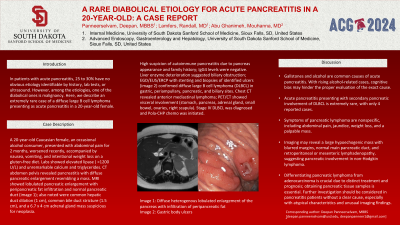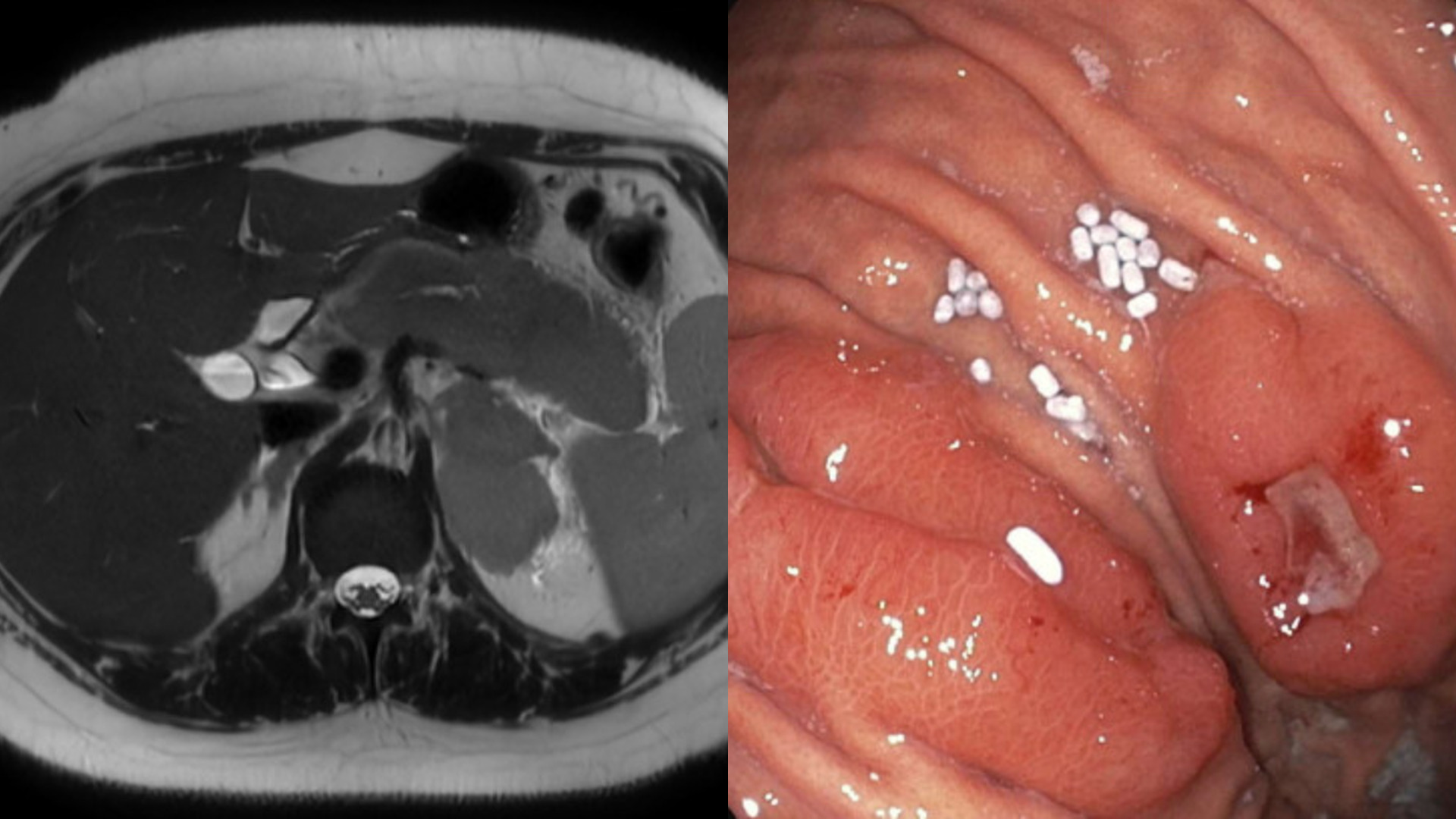Monday Poster Session
Category: Biliary/Pancreas
P1851 - A Rare Diabolical Etiology for Acute Pancreatitis in a 20-Year-Old: A Case Report
Monday, October 28, 2024
10:30 AM - 4:00 PM ET
Location: Exhibit Hall E

Has Audio

Deepan Panneerselvam, MBBS
University of South Dakota Sanford School of Medicine
Sioux Falls, SD
Presenting Author(s)
Deepan Panneerselvam, MBBS, Randall Lamfers, MD, Mouhanna Abu Ghanimeh, MD
University of South Dakota Sanford School of Medicine, Sioux Falls, SD
Introduction: In patients with acute pancreatitis, 25 to 30% have no obvious etiology identifiable by history, lab tests, or ultrasound. However, among the etiologies, one of the diabolical ones is malignancy. Here, we describe an extremely rare case of a diffuse large B cell lymphoma presenting as acute pancreatitis in a 20-year-old female.
Case Description/Methods: A 20-year-old Caucasian female, an occasional alcohol consumer, presented with abdominal pain for 2 months, worsened recently, accompanied by nausea, vomiting, and intentional weight loss on a gluten-free diet. Labs showed elevated lipase ( >1200 U/L) and unremarkable calcium and triglycerides. CT abdomen pelvis revealed pancreatitis with diffuse pancreatic enlargement resembling a mass. MRI showed lobulated pancreatic enlargement with peripancreatic fat infiltration and normal pancreatic duct (image 1); also noted were common hepatic duct dilation (1 cm), common bile duct stricture (1.5 cm), and a 6.7 x 4 cm adrenal gland mass suspicious for neoplasia. High suspicion of autoimmune pancreatitis due to pancreas appearance and family history; IgG4 levels were negative. Liver enzyme deterioration suggested biliary obstruction; EGD/EUS/ERCP with stenting and biopsies of identified ulcers (image 2) confirmed diffuse large B cell lymphoma (DLBCL) in gastric, periampullary, pancreatic, and biliary sites. Chest CT revealed anterior mediastinal lymphoma; PET/CT showed visceral involvement (stomach, pancreas, adrenal gland, small bowel, ovaries, right scapula). Stage IV DLBCL was diagnosed and Pola-CHP chemo was initiated.
Discussion: Gallstones and alcohol are common causes of acute pancreatitis. With rising alcohol-related cases, cognitive bias may hinder the proper evaluation of the exact cause. Acute pancreatitis presenting with secondary pancreatic involvement of DLBCL is extremely rare, with only 4 reported cases. Symptoms of pancreatic lymphoma are nonspecific, including abdominal pain, jaundice, weight loss, and a palpable mass. Imaging may reveal a large hypoechogenic mass with blurred margins, normal main pancreatic duct, and retroperitoneal or mesenteric lymphadenopathy, suggesting pancreatic involvement in non-Hodgkin lymphoma. Differentiating pancreatic lymphoma from adenocarcinoma is crucial due to distinct treatment and prognosis; obtaining pancreatic tissue samples is essential. Further investigation should be considered in pancreatitis patients without a clear cause, especially with atypical characteristics and unusual imaging findings.

Disclosures:
Deepan Panneerselvam, MBBS, Randall Lamfers, MD, Mouhanna Abu Ghanimeh, MD. P1851 - A Rare Diabolical Etiology for Acute Pancreatitis in a 20-Year-Old: A Case Report, ACG 2024 Annual Scientific Meeting Abstracts. Philadelphia, PA: American College of Gastroenterology.
University of South Dakota Sanford School of Medicine, Sioux Falls, SD
Introduction: In patients with acute pancreatitis, 25 to 30% have no obvious etiology identifiable by history, lab tests, or ultrasound. However, among the etiologies, one of the diabolical ones is malignancy. Here, we describe an extremely rare case of a diffuse large B cell lymphoma presenting as acute pancreatitis in a 20-year-old female.
Case Description/Methods: A 20-year-old Caucasian female, an occasional alcohol consumer, presented with abdominal pain for 2 months, worsened recently, accompanied by nausea, vomiting, and intentional weight loss on a gluten-free diet. Labs showed elevated lipase ( >1200 U/L) and unremarkable calcium and triglycerides. CT abdomen pelvis revealed pancreatitis with diffuse pancreatic enlargement resembling a mass. MRI showed lobulated pancreatic enlargement with peripancreatic fat infiltration and normal pancreatic duct (image 1); also noted were common hepatic duct dilation (1 cm), common bile duct stricture (1.5 cm), and a 6.7 x 4 cm adrenal gland mass suspicious for neoplasia. High suspicion of autoimmune pancreatitis due to pancreas appearance and family history; IgG4 levels were negative. Liver enzyme deterioration suggested biliary obstruction; EGD/EUS/ERCP with stenting and biopsies of identified ulcers (image 2) confirmed diffuse large B cell lymphoma (DLBCL) in gastric, periampullary, pancreatic, and biliary sites. Chest CT revealed anterior mediastinal lymphoma; PET/CT showed visceral involvement (stomach, pancreas, adrenal gland, small bowel, ovaries, right scapula). Stage IV DLBCL was diagnosed and Pola-CHP chemo was initiated.
Discussion: Gallstones and alcohol are common causes of acute pancreatitis. With rising alcohol-related cases, cognitive bias may hinder the proper evaluation of the exact cause. Acute pancreatitis presenting with secondary pancreatic involvement of DLBCL is extremely rare, with only 4 reported cases. Symptoms of pancreatic lymphoma are nonspecific, including abdominal pain, jaundice, weight loss, and a palpable mass. Imaging may reveal a large hypoechogenic mass with blurred margins, normal main pancreatic duct, and retroperitoneal or mesenteric lymphadenopathy, suggesting pancreatic involvement in non-Hodgkin lymphoma. Differentiating pancreatic lymphoma from adenocarcinoma is crucial due to distinct treatment and prognosis; obtaining pancreatic tissue samples is essential. Further investigation should be considered in pancreatitis patients without a clear cause, especially with atypical characteristics and unusual imaging findings.

Figure: Image 1: Diffuse heterogenous lobulated enlargement of the pancreas with infiltration of peripancreatic fat
Image 2: Gastric body ulcers
Image 2: Gastric body ulcers
Disclosures:
Deepan Panneerselvam indicated no relevant financial relationships.
Randall Lamfers indicated no relevant financial relationships.
Mouhanna Abu Ghanimeh indicated no relevant financial relationships.
Deepan Panneerselvam, MBBS, Randall Lamfers, MD, Mouhanna Abu Ghanimeh, MD. P1851 - A Rare Diabolical Etiology for Acute Pancreatitis in a 20-Year-Old: A Case Report, ACG 2024 Annual Scientific Meeting Abstracts. Philadelphia, PA: American College of Gastroenterology.
